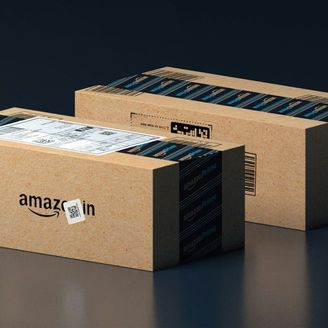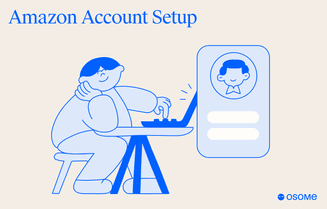How To Sell on Amazon in the UK: Your 2026 Success Guide
- Modified: 26 December 2024
- 12 min read
- Ecommerce, Starting a Company


Heather Cameron
Author
Heather believes in the power of great storytelling and is here to craft compelling copy that informs and inspires readers. With an extensive background in digital marketing, she has experience writing for various industries, from finance to travel. As Osome’s copywriter, Heather creates content that empowers entrepreneurs and small business owners to boost their business with expert guidance, helpful accounting tips and insights into the latest fintech trends.
Curious about how to sell on Amazon? This guide shows you everything you need to get started and succeed—from setting up your account to shipping your products.
Key Takeaways
- You must set up a Seller Central account account to sell products on Amazon. Sellers can choose between the Individual selling plan and the Professional selling plan based on their sales goals. You cannot use your customer account to sell on Amazon.
- Choosing between Fulfillment by Amazon (FBA) and Fulfillment by Merchant (FBM) is crucial for order efficiency, with FBA providing benefits like Prime eligibility.
- Create product listings with effective titles, high-quality images, and detailed descriptions is vital for increasing visibility and conversion rates.
Setting Up Your Amazon Seller Account
The first step to selling on Amazon is setting up your professional seller account. It’s the gateway to accessing millions of customers and putting your products in front of a massive audience. Amazon provides Individual and Professional selling plans, each with respective fees. Regardless of your experience in online retail, creating a selling account is necessary to get started. The registration process is straightforward; however, evaluating your business capabilities and setting realistic goals beforehand is crucial.
To ensure smooth financial operations as your business grows, consider our specialised ecommerce accounting services. From managing sales tax to tracking inventory and handling profit margins, we help you maintain accurate financial records so you can focus on scaling your Amazon store.

It's free to register as a seller on Amazon, though there are fees associated with the selling plans. The Professional selling plan is ideal for sellers who plan to sell a large volume of products, while the Individual plan might be suitable for those who only have a few items to sell on Amazon. A professional selling plan is recommended for those aiming for higher sales.
Amazon also provides a handful of new seller incentives and resources to help new businesses take off effectively. Finally, make sure to complete the verification process as identity verification protects sellers from cybersecurity threats and fraudulent conduct.
Requirements for Amazon Seller Account
You must provide specific information and documentation, including your Amazon customer account details, if you want to sell on Amazon. Other necessary information includes a valid email address, credit card, identification, and bank account details. Business details and identity verification are crucial steps in the registration process.
The identity verification process protects sellers and ensures a secure platform for all users. While a business license is generally not required, providing accurate information is essential for successful account approval.
New sellers can benefit from incentives offered by Amazon, making it an attractive platform to start selling your online retail business.
Navigating Seller Central
Once you are set up as a seller, you will gain access to Amazon Seller Central, the hub for managing your Amazon business. Seller Central allows you to list and price products, manage inventory, fulfil orders, create promotions, and track payments, making it an invaluable tool.
The Amazon Seller app is a powerful tool that enables you to manage your business on the go. Features such as the Account Health dashboard, centralised inventory management, and user addition capabilities make Seller Central essential for streamlining operations and fostering business growth.
Choosing the Right Fulfillment Method
Selecting the appropriate fulfilment method ensures efficient order fulfilment and customer satisfaction. Amazon provides two primary methods: Fulfillment by Amazon (FBA) and Fulfillment by Merchant (FBM). FBA, managed by the Amazon Fulfillment Center, allows sellers to leverage Amazon’s extensive fulfilment network to significantly enhance shipping efficiency and customer service without having to develop their own site or store their inventories separately.
FBM, on the other hand, involves third-party sellers managing their inventory and shipping processes without using the Amazon warehouse. This method might be more suitable for bulky, heavy, or made-to-order products. The choice between FBA and FBM depends on factors such as product nature, shipping efficiency, and customer service demands.
Costs associated with FBA and FBM
Knowing the costs of FBA and FBM is crucial for making an informed decision. FBA fees include storage fees and fulfilment fees, which vary based on the dimensions and weight of your products. Additionally, FBA sellers may incur disposal and removal fees for unsellable inventory.
FBM sellers, on the other hand, bear the responsibility for shipping and customer service costs, as well as storage fees, since they operate very much like independent sellers and mainly leverage Amazon's vast customer base.
While FBA offers the convenience of Amazon handling these aspects, the FBA fees might be higher than FBM, depending on the size and weight of your products and your business goals.
Benefits of using FBA
FBA offers numerous benefits. Amazon manages all customer support for FBA sellers, including returns and customer service. This can save you significant time and effort, allowing you to focus on other aspects of your business.
FBA also makes your products eligible for Prime shipping, which can attract more customers and increase sales. Additionally, FBA provides access to European marketplaces, further expanding your reach. FBA is an ideal choice for small, lightweight products. These items typically have rapid turnover.
Creating Effective Product Listings
Effective listings are vital for attracting customers and driving sales on Amazon. Optimised listings for different products can significantly enhance click-through and conversion rates. The product detail page is designed to help customers decide whether the product meets their needs.
Keyword research is essential for enhancing search engine optimisation (SEO), which increases your product’s visibility on Amazon. Avoid adding irrelevant keywords to maintain the relevancy of your listings.
Key elements of creating compelling listings include:
Crafting compelling product titles
Product titles are the first thing potential customers see, making them critical for attracting attention. A compelling product title includes key information such as the brand, product type, and essential features.
Keeping Amazon product titles under 80 characters improves searchability and visibility. Keeping titles concise yet informative helps in capturing customer interest and improving search rankings.
High-quality product images
High-quality product images are crucial for making a strong first impression on potential buyers. Amazon requires product images to have a minimum resolution of 1,000 DPI to ensure clarity when customers zoom in.
Adding videos or using 3D models can give shoppers a more comprehensive view of your products, increasing the likelihood of purchase. The main product photo should clearly show the product to enhance the product detail page.
Choosing the right product category
The right categories ensure your customers are shown to the right customer groups. Conduct market research to see what categories your competitors list similar items under. The same product might perform differently under different categories.
Detailed product descriptions
Detailed product descriptions help customers understand a product's features and benefits. Use bullet points on the product detail page to make it easier for Amazon customers to find important information. If multiple sellers are selling the same product, the one with the most informative and user-friendly description tends to attract customers the most.
Short, descriptive sentences highlighting key features enhance the effectiveness of your product descriptions. Providing clear and concise information helps in building customer trust and improving conversion rates.
Optimising Your Pricing Strategy
The right pricing strategy is critical for competing effectively on Amazon. Sellers must consider all costs associated with their products, including acquisition, shipping, and Amazon fees, to set appropriate selling prices.

Profitability and maximising profits are the main variables to consider when setting prices. Evaluating the competition and pricing of top keywords can help determine your upper price limit.
Using automated pricing tools
Amazon’s Automate Pricing tool automatically adjusts product prices based on market conditions. This tool uses algorithms to ensure that sellers remain competitive without constant manual intervention. These tools save time and effort while maximising potential sales.
They help sellers maintain competitive pricing and respond quickly to market changes.
Maintaining price stability
Price stability fosters customer loyalty and trust. Stable pricing helps build a sustainable brand and avoid price wars that can erode profit margins.
By monitoring sales volume and competition, sellers can adjust prices strategically while maintaining overall stability. Ensuring compliance with Amazon’s pricing policy is also essential to avoid account suspension.
Driving Traffic to Your Amazon Store
Driving traffic to your Amazon store is essential for increasing visibility and sales. Combining organic traffic strategies with targeted marketing efforts enhances your product’s attractiveness to consumers. Effective pricing, shipping strategies, and targeted advertising can greatly increase your product’s visibility and appeal.
Tools like Lightning Deals attract new customers and prompt immediate sales. They are extremely helpful when you first start selling on Amazon.
Leveraging Amazon Sponsored Products
Amazon Sponsored Products are promotional services where sellers bid on search terms to display ads beside search results in different product categories. These ads can be displayed above, alongside, or below search results and on product detail pages.
Sponsored Product ads drive traffic to your listings, increasing visibility and potential sales. They are an effective selling strategy to reach a broader audience and enhance your marketing strategy to sell products.
Amazon Buy Box
The buy box refers to the "Buy Now" button that sometimes shows up on a product's page. Amazon internal data determines if a product is eligible for this function, and it is highly efficient as it contributes to 82% of Amazon sales. You must maintain competitive pricing, a low late shipment rate, a high valid tracking rate (VTR), and a positive feedback rating to become eligible.
Building an email list
A robust email list drives traffic and ensures a successful product launch. Implementing lead magnets, such as exclusive discounts or helpful resources, can encourage sign-ups. Utilising social media platforms to promote your email list, create your own brand, and attract more customers.
Regular engagement with subscribers through informative content and personalised offers maintains interest and drives traffic.
External marketing tactics
External marketing tactics like utilising social media platforms drive significant traffic to your Amazon listings. Facebook ads are one of the most important external paid traffic sources for selling on Amazon.
Discount codes and pointing all product links to Amazon can help rank in top search results and maximise sales. Effective use of platforms like YouTube, Facebook, and Twitter can reach potential customers and increase visibility.
Finally, you can create your own brand name to stand out from the competition and you can use Amazon's brand registry to easily track, monitor, and protect your intellectual properties when you sell on Amazon.
Gaining Positive Customer Reviews
Positive customer reviews are essential for selling on Amazon as they influence seller feedback ratings. The quantity and quality of reviews play a vital role in boosting your conversion rate. They are essential components that can significantly impact your success. Managing customer interactions on product pages proactively improves overall product reputation and sales.
Requesting feedback from satisfied customers is an effective way to get high-quality positive reviews. You can also offer an incentive to encourage people to leave their feedback.
Post-purchase follow-up emails
A follow-up email after a purchase significantly increases the chances of receiving a review. Including a direct link to the review page in follow-up emails simplifies the process for customers and enhances the likelihood of feedback.
Approach customers neutrally when asking for reviews and avoid pressuring them to leave positive feedback. Effective follow-up emails serve as effective customer interaction and can reel them back in for future purchases.
Handling negative feedback
Effectively handling negative feedback can turn frustrated customers into loyal advocates. Engaging with customers who leave negative reviews may encourage them to change their feedback to positive. Responding to negative reviews can foster trust and improve customer experience.
Proactively managing negative feedback is essential for maintaining a positive image and enhancing customer conversion.
Monitoring Performance Metrics
Monitoring performance metrics assesses the effectiveness of your sales and marketing strategies. These metrics can help you identify areas for improvement and optimise your operations. Centralised inventory management is essential for overseeing stock across various platforms effectively and tracking units sold.
Low inventory turnover rates might indicate poor sales and excess inventory. Especially when selling seasonal items, monitoring historical sales rank and weather patterns can provide valuable insights.
Inventory to sales ratio
An optimal inventory-to-sales ratio ensures adequate stock levels to meet customer demand without overstocking. Days of Inventory (DOI) indicates the average number of days an item is held in inventory before being sold. Determining order quantity through DOI helps in avoiding overstocking or stockouts.
Diversifying your product portfolio can lower the risk of losing SKUs and aid in maintaining a balanced inventory strategy.
Gross Margin Return on Investment (GMROI)
GMROI measures inventory profitability and is a key metric for assessing how effectively your business is turning inventory into profits. A GMROI ratio higher than 1 indicates that your business is selling inventory for more than its total acquisition cost.
Monitoring GMROI identifies the most profitable products and those needing strategic adjustments. Continually analysing this metric ensures your business remains financially healthy and competitive.
Cash-to-cash cycle
The cash-to-cash cycle represents the time taken from outlaying cash for raw materials to receiving cash from product sales. A shorter cash-to-cash cycle indicates better efficiency in managing cash flow and inventory turnover.
Optimising the cash-to-cash cycle involves streamlining operations, reducing lead times, and improving supply chain efficiency. This metric is critical for maintaining liquidity and ensuring the smooth operation of your business.

Enhancing Customer Service
Outstanding customer service is the best marketing tool on Amazon and is essential for sustaining and growing your customer base. Fulfilling customer orders by Amazon (FBA) simplifies customer service by managing inquiries and returns on behalf of sellers.
Direct email communication channels are essential for engaging customers and promoting products effectively. Customer reviews serve as social proof, helping potential buyers gauge product reliability and quality.
Quick response times
Timely responses to customer messages make your buyers feel heard. Aim to respond to customer emails within 24 hours to improve satisfaction and build trust, and always fulfil customer orders within the first 24 hours of customer purchases.
You should also follow up on the item sold to ensure proper delivery and obtain valuable feedback. Automating the email process for requesting reviews can streamline engagement and improve customer relationships.
Engaging on product pages
Active page engagement builds customer trust and satisfaction. Actively managing seller feedback helps maintain a positive image. Answering questions in the Q&A section assists potential buyers and demonstrates a commitment to customer service.
Commenting on negative product reviews and offering instant help can potentially turn negative feedback into positive outcomes. Effective engagement on your listings can lead to increased sales and customer loyalty.
Summary
Sell on Amazon in the UK introduces a wealth of opportunities for businesses to reach a massive audience and grow their sales. Setting up your Seller Central account is the first step, followed by choosing the right fulfilment method and creating effective listings. Optimising your pricing strategy and driving traffic to your Amazon store is crucial for success.
Gaining positive customer reviews, monitoring performance metrics, and enhancing customer service is key to building a sustainable and profitable business on Amazon. By following the strategies outlined in this guide, you can navigate the complexities of selling on Amazon and achieve remarkable success. Start your journey today and unlock the potential of your Amazon store.
Reach out to our team of professional accountants for a smooth and profitable journey as an Amazon seller!






